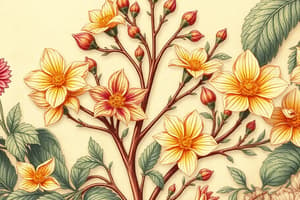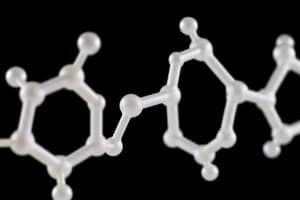Podcast
Questions and Answers
What is the primary therapeutic use of anthraquinone glycosides?
What is the primary therapeutic use of anthraquinone glycosides?
- Natural dye production
- Antifungal treatment
- Laxatives or cathartics (correct)
- Antioxidant therapy
Which of the following plants is NOT recommended due to its irritant properties?
Which of the following plants is NOT recommended due to its irritant properties?
- Cascara sagrada
- Aloe (correct)
- Frangula
- Senna
What type of glycosides do Sennosides A and B represent?
What type of glycosides do Sennosides A and B represent?
- Simple glycosides
- Hetero-Dianthrones
- Anthraquinone monomers
- Homo-Dianthrones (correct)
In the context of anthraquinones, why is the sugar moiety essential?
In the context of anthraquinones, why is the sugar moiety essential?
Which statement regarding dimeric anthracene derivatives is accurate?
Which statement regarding dimeric anthracene derivatives is accurate?
How do anthraquinone glycosides exert their action as stimulant cathartics?
How do anthraquinone glycosides exert their action as stimulant cathartics?
Which characteristic is true about homo-dianthrones?
Which characteristic is true about homo-dianthrones?
What is the relationship between oxidation level and anthraquinone activity?
What is the relationship between oxidation level and anthraquinone activity?
What is the primary use of Cascara Sagrada bark?
What is the primary use of Cascara Sagrada bark?
What effect does aging Cascara Sagrada bark for at least one year have?
What effect does aging Cascara Sagrada bark for at least one year have?
Which active constituent is present in Frangula bark?
Which active constituent is present in Frangula bark?
What is the primary constituent responsible for the laxative effect in Aloe?
What is the primary constituent responsible for the laxative effect in Aloe?
What is the role of the C-linked glucose at C-10 in Aloe?
What is the role of the C-linked glucose at C-10 in Aloe?
Which of the following statements about Rhubarb is correct?
Which of the following statements about Rhubarb is correct?
What distinguishes the use of Aloe for treating burns and skin irritations?
What distinguishes the use of Aloe for treating burns and skin irritations?
Which compound is absent from Sennosides A and B?
Which compound is absent from Sennosides A and B?
What is the primary active constituent of Aloe that contributes to its medicinal properties?
What is the primary active constituent of Aloe that contributes to its medicinal properties?
What is a significant characteristic of the use of Frangula bark in medicinal preparations?
What is a significant characteristic of the use of Frangula bark in medicinal preparations?
Which plant is recognized for having a significant amount of anthraquinone glycosides associated with cathartic effects?
Which plant is recognized for having a significant amount of anthraquinone glycosides associated with cathartic effects?
What type of glycoside is notably contained in Sennosides C and D?
What type of glycoside is notably contained in Sennosides C and D?
What effect does the C-C bond have on anthrone compounds?
What effect does the C-C bond have on anthrone compounds?
In what form is the active ingredient of Rhubarb traditionally used?
In what form is the active ingredient of Rhubarb traditionally used?
What is the purpose of storing Cascara Sagrada bark for at least one year prior to its use?
What is the purpose of storing Cascara Sagrada bark for at least one year prior to its use?
Which compound primarily contributes to the cathartic action of rhubarb?
Which compound primarily contributes to the cathartic action of rhubarb?
What is the primary effect of anthraquinone glycosides on the colon?
What is the primary effect of anthraquinone glycosides on the colon?
Which component is critical for the therapeutic activity of anthraquinone compounds?
Which component is critical for the therapeutic activity of anthraquinone compounds?
What distinguishes hetero-dianthrones from homo-dianthrones?
What distinguishes hetero-dianthrones from homo-dianthrones?
Which of the following represents a major constituent found in Senna leaves?
Which of the following represents a major constituent found in Senna leaves?
Which of the following statements about Sennosides C and D is accurate?
Which of the following statements about Sennosides C and D is accurate?
What is the reason Aloe and rhubarb are not recommended as laxatives compared to other anthraquinones?
What is the reason Aloe and rhubarb are not recommended as laxatives compared to other anthraquinones?
What distinguishes the A group of Sennidins from the B group specifically?
What distinguishes the A group of Sennidins from the B group specifically?
Which process can interchange different anthraquinone groups?
Which process can interchange different anthraquinone groups?
Flashcards are hidden until you start studying
Study Notes
### Anthraquinone Glycosides
- Oxygenated derivatives with pharmacological importance used as laxatives, cathartics, anti-inflammatory agents, antibacterial, antifungal, and natural dyes.
- Present in drugs like cascara sagrada, frangula, aloe, rhubarb, and senna.
- Activity decreases as oxidation level increases.
Aglycones
- Anthracene derivatives found in plants.
Dimeric Anthracene Derivatives
- Formed from two anthracene units connected by a covalent C-C bond through C-10.
Homo-Dianthrones
- Two anthrone moieties are similar.
- Examples: Sennidins A&B and their corresponding glycosides Sennosides A&B.
- Formed of two Rhein monomers.
- A group is (l)-form while the B group is meso compounds with zero optical rotation.
Hetero-Dianthrones
-
Two anthrone moieties are different.
-
Examples: Sennidins C&D and their corresponding glycosides Sennosides C&D.
-
Formed of one Rhein and one Aloe-emodin monomers.
-
C group is (l)-form while the D group is meso compounds with zero optical rotation.
-
Free anthraquinones without sugar moiety exhibit little therapeutic activity.
-
Sugar is essential for transporting the aglycone to the site of action in the large intestine.
-
Anthraquinone group can be interchanged by oxidation or reduction.
Mechanism of Action
- Anthraquinone and related glycosides are stimulant cathartics.
- Action: Increase the tone of smooth muscle in the colon wall and stimulate secretion of water and electrolytes into the large intestine.
- Cascara sagrada, frangula, and senna are the preferred drugs.
- Aloe and rhubarb are not recommended due to their irritant properties.
Numbering System and Nomenclature
- Numbering can start from any corner, ensuring substituents have the smallest number.
Plants Containing Anthraquinone Glycosides
Senna
- Dried leaves of Cassia acutifolia, known as Alexandria senna.
- Active constituents: Dimeric glycosides whose aglycons are composed of aloe-emodin and/or rhein.
- Sennosides A and B are major constituents, stereoisomers whose aglycones are rhein dianthrone.
- Sennosides C and D are minor constituents, composed of one molecule of rhein and one of aloe-emodin.
- C-C bond protects the anthrone from oxidation.
- Use: As cathartics.
Cascara Sagrada Bark
- Dried bark of Rhamnus purshianus.
- Aged for one year to lose griping properties.
- Stored to change the reduced form (drastic griping) into the oxidized form (less griping).
- Active Constituents:
- Cascarosides A&B (glycosides of barbaloin)
- Cascarosides C&D (glycosides of chrysaloin which is deoxy barbaloin)
Frangula
- Dried bark of Rhamnus frangula.
- Laxative effect due to anthraquinone glycosides.
- Aged for one year before use in medicinal preparations.
- Consists of:
- Frangulin (frangula emodin rhamnoside)
- Glucofrangulin (frangula emodin glucorhamnoside)
Aloe
- Dried juice of the leaves of Aloe barbadensis.
- Active constituents: Anthraquinone glycosides, the principal ones being aloins A and B (Barbaloin).
- C-linked glucose at C-10 protects anthrones from oxidation.
- Active constituents vary between species.
- Uses:
- As a cathartic
- Fresh juice for treating burns and skin irritations.
- Extracted gel for sunburn, deep thermal burns, and radiation burns.
- Provides pain relief, reduces itching, minimizes keratosis and ulceration.
Rhubarb
- Dried rhizome and root of Rheum officinale.
- Active constituents: Rhein anthrones.
- Uses: As cathartics.
Anthraquinone Glycosides
- Are oxygenated derivatives of pharmacological importance.
- Used as laxatives, cathartics, anti-inflammatory, antibacterial, and antifungal agents.
- Also act as natural dyes.
- Present in drugs like cascara sagrada, frangula, aloe, rhubarb, and senna.
Anthraquinone Aglycones
- Anthracene derivatives found in plants.
- Activity decreases as oxidation levels increase.
Dimeric Anthracene Derivatives
- Derived from two anthracene units connected by a covalent C-C bond through C-10.
Homo-Dianthrones
- The two anthrone moieties are similar.
- Examples include:
- Sennidins A&B
- Sennosides A&B
- All formed of two Rhein monomers.
- Group A are (l)-form.
- Group B are meso compounds with zero optical rotation.
Hetero-Dianthrones
- The two anthrone moieties are different.
- Examples include:
- Sennidins C&D
- Sennosides C&D
- All formed of one Rhein and one Aloe-emodin monomer.
- Group C are (l)-form.
- Group D are meso compounds with zero optical rotation.
- Free anthraquinones exhibit little therapeutic activity without the sugar moiety.
- The sugar is essential for transporting the aglycone to the site of action in the large intestine.
Anthraquinone Group Interchangeability
- Anthraquinone group members can be interconverted by oxidation or reduction.
Mechanism of Action
- Anthraquinone glycosides are stimulant cathartics.
- Exert their action by increasing colon smooth muscle tone.
- Stimulate water and electrolyte secretion into the large intestine.
- Cascara sagrada, frangula, and senna are the preferred drugs.
- Aloe and rhubarb are not recommended due to their irritant properties.
Numbering System and Nomenclature
- Numbering starts from any corner.
- Substituents are given the smallest number.
Plants Containing Anthraquinone Glycosides
Senna
- Dried leaves of Cassia acutifolia (Alexandria senna).
- Active constituents are dimeric glycosides with aglycones composed of aloe-emodin and/or rhein.
- Major constituents:
- Sennosides A and B (stereoisomers with rhein dianthrone aglycones).
- Minor constituents:
- Sennosides C and D (one molecule of rhein and one of aloe-emodin).
- The C-C bond protects the anthrone from oxidation.
- Uses: Cathartics.
- Sennosides A, B, C, and D contain glucose.
Cascara Sagrada Bark
- Dried bark of Rhamnus purshianus.
- Aged for at least one year before use to lose griping properties.
- Storage allows conversion of the reduced form (drastic griping action) to the oxidized form (less griping action).
- Active constituents include:
- Cascarosides A&B (glycosides of barbaloin).
- Cascarosides C&D (glycosides of chrysaloin, a deoxy barbaloin).
Frangula
- Dried bark of Rhamnus frangula.
- Laxative effects are due to the presence of anthraquinone glycosides.
- Aged for a year or more before medicinal use.
- Consists of:
- Frangulin (frangula emodin rhamnoside).
- Glucofrangulin (frangula emodin glucorhamnoside).
Aloe
- Dried juice of Aloe barbadensis leaves.
- Contains multiple anthraquinone glycosides.
- Principal ones include:
- (Barbaloin) aloins A and B.
- C-linked glucose at C-10 protects anthrones from oxidation.
- Active constituents vary qualitatively and quantitatively based on species.
- Uses:
- Cathartic by acting on the large intestine.
- Fresh juice for burns and skin irritations.
- Extracted gel blended with lanolin base as ointment for sunburn, deep burns, and radiation burns.
- Relieves pain, itching, and minimizes keratosis and ulceration.
Rhubarb
- Dried rhizome and root of Rheum officinale.
- Active constituents:
- Rhein anthrones.
- Uses: Cathartics.
Studying That Suits You
Use AI to generate personalized quizzes and flashcards to suit your learning preferences.




